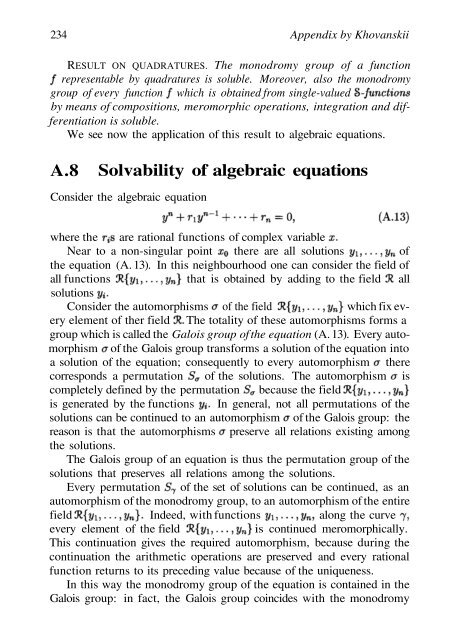Abel's theorem in problems and solutions - School of Mathematics
Abel's theorem in problems and solutions - School of Mathematics
Abel's theorem in problems and solutions - School of Mathematics
Create successful ePaper yourself
Turn your PDF publications into a flip-book with our unique Google optimized e-Paper software.
234 Appendix by Khovanskii<br />
RESULT ON QUADRATURES. The monodromy group <strong>of</strong> a function<br />
representable by quadratures is soluble. Moreover, also the monodromy<br />
group <strong>of</strong> every function which is obta<strong>in</strong>ed from s<strong>in</strong>gle-valued<br />
by means <strong>of</strong> compositions, meromorphic operations, <strong>in</strong>tegration <strong>and</strong> differentiation<br />
is soluble.<br />
We see now the application <strong>of</strong> this result to algebraic equations.<br />
A.8 Solvability <strong>of</strong> algebraic equations<br />
Consider the algebraic equation<br />
where the are rational functions <strong>of</strong> complex variable<br />
Near to a non-s<strong>in</strong>gular po<strong>in</strong>t there are all <strong>solutions</strong> <strong>of</strong><br />
the equation (A. 13). In this neighbourhood one can consider the field <strong>of</strong><br />
all functions that is obta<strong>in</strong>ed by add<strong>in</strong>g to the field all<br />
<strong>solutions</strong><br />
Consider the automorphisms <strong>of</strong> the field which fix every<br />
element <strong>of</strong> ther field The totality <strong>of</strong> these automorphisms forms a<br />
group which is called the Galois group <strong>of</strong> the equation (A. 13). Every automorphism<br />
<strong>of</strong> the Galois group transforms a solution <strong>of</strong> the equation <strong>in</strong>to<br />
a solution <strong>of</strong> the equation; consequently to every automorphism there<br />
corresponds a permutation <strong>of</strong> the <strong>solutions</strong>. The automorphism is<br />
completely def<strong>in</strong>ed by the permutation because the field<br />
is generated by the functions In general, not all permutations <strong>of</strong> the<br />
<strong>solutions</strong> can be cont<strong>in</strong>ued to an automorphism <strong>of</strong> the Galois group: the<br />
reason is that the automorphisms preserve all relations exist<strong>in</strong>g among<br />
the <strong>solutions</strong>.<br />
The Galois group <strong>of</strong> an equation is thus the permutation group <strong>of</strong> the<br />
<strong>solutions</strong> that preserves all relations among the <strong>solutions</strong>.<br />
Every permutation <strong>of</strong> the set <strong>of</strong> <strong>solutions</strong> can be cont<strong>in</strong>ued, as an<br />
automorphism <strong>of</strong> the monodromy group, to an automorphism <strong>of</strong> the entire<br />
field Indeed, with functions along the curve<br />
every element <strong>of</strong> the field is cont<strong>in</strong>ued meromorphically.<br />
This cont<strong>in</strong>uation gives the required automorphism, because dur<strong>in</strong>g the<br />
cont<strong>in</strong>uation the arithmetic operations are preserved <strong>and</strong> every rational<br />
function returns to its preced<strong>in</strong>g value because <strong>of</strong> the uniqueness.<br />
In this way the monodromy group <strong>of</strong> the equation is conta<strong>in</strong>ed <strong>in</strong> the<br />
Galois group: <strong>in</strong> fact, the Galois group co<strong>in</strong>cides with the monodromy

















